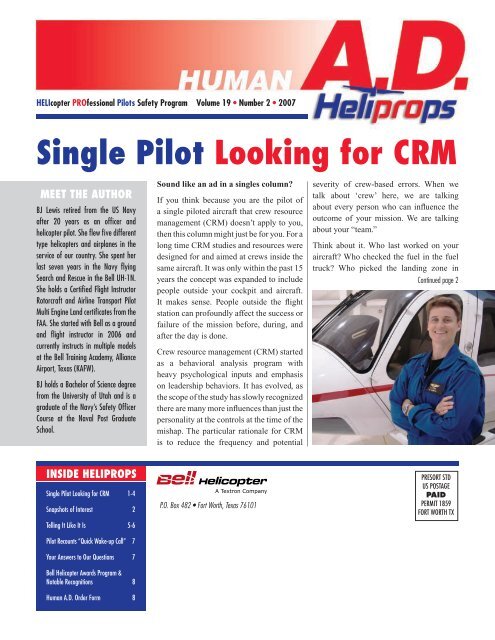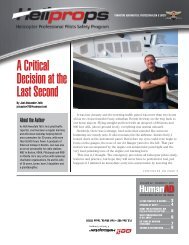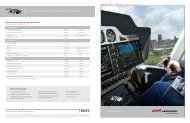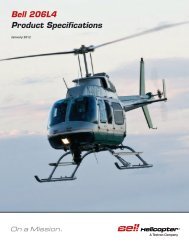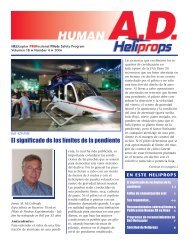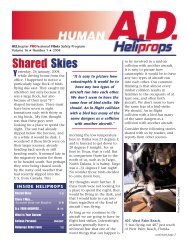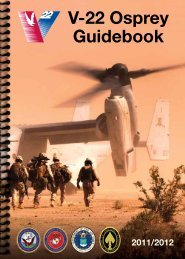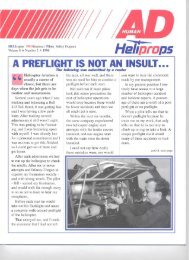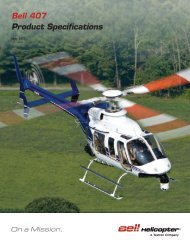Single Pilot Looking for CRM - Bell Helicopter
Single Pilot Looking for CRM - Bell Helicopter
Single Pilot Looking for CRM - Bell Helicopter
Create successful ePaper yourself
Turn your PDF publications into a flip-book with our unique Google optimized e-Paper software.
HELIcopter PROfessional <strong>Pilot</strong>s Safety Program Volume 19 • Number 2 • 2007<br />
<strong>Single</strong> <strong>Pilot</strong> <strong>Looking</strong> <strong>for</strong> <strong>CRM</strong><br />
MEET THE AUTHOR<br />
BJ Lewis retired from the US Navy<br />
after 20 years as an officer and<br />
helicopter pilot. She flew five different<br />
type helicopters and airplanes in the<br />
service of our country. She spent her<br />
last seven years in the Navy flying<br />
Search and Rescue in the <strong>Bell</strong> UH-1N.<br />
She holds a Certified Flight Instructor<br />
Rotorcraft and Airline Transport <strong>Pilot</strong><br />
Multi Engine Land certificates from the<br />
FAA. She started with <strong>Bell</strong> as a ground<br />
and flight instructor in 2006 and<br />
currently instructs in multiple models<br />
at the <strong>Bell</strong> Training Academy, Alliance<br />
Airport, Texas (KAFW).<br />
BJ holds a Bachelor of Science degree<br />
from the University of Utah and is a<br />
graduate of the Navy’s Safety Officer<br />
Course at the Naval Post Graduate<br />
School.<br />
INSIDE HELIPROPS<br />
<strong>Single</strong> <strong>Pilot</strong> <strong>Looking</strong> <strong>for</strong> <strong>CRM</strong> 1-4<br />
Snapshots of Interest 2<br />
Telling It Like It Is 5-6<br />
<strong>Pilot</strong> Recounts “Quick Wake-up Call” 7<br />
Your Answers to Our Questions 7<br />
<strong>Bell</strong> <strong>Helicopter</strong> Awards Program &<br />
Notable Recognitions 8<br />
Human A.D. Order Form 8<br />
Sound like an ad in a singles column?<br />
If you think because you are the pilot of<br />
a single piloted aircraft that crew resource<br />
management (<strong>CRM</strong>) doesn’t apply to you,<br />
then this column might just be <strong>for</strong> you. For a<br />
long time <strong>CRM</strong> studies and resources were<br />
designed <strong>for</strong> and aimed at crews inside the<br />
same aircraft. It was only within the past 15<br />
years the concept was expanded to include<br />
people outside your cockpit and aircraft.<br />
It makes sense. People outside the flight<br />
station can profoundly affect the success or<br />
failure of the mission be<strong>for</strong>e, during, and<br />
after the day is done.<br />
Crew resource management (<strong>CRM</strong>) started<br />
as a behavioral analysis program with<br />
heavy psychological inputs and emphasis<br />
on leadership behaviors. It has evolved, as<br />
the scope of the study has slowly recognized<br />
there are many more influences than just the<br />
personality at the controls at the time of the<br />
mishap. The particular rationale <strong>for</strong> <strong>CRM</strong><br />
is to reduce the frequency and potential<br />
P.O. Box 482 • Fort Worth, Texas 76101<br />
severity of crew-based errors. When we<br />
talk about ‘crew’ here, we are talking<br />
about every person who can influence the<br />
outcome of your mission. We are talking<br />
about your “team.”<br />
Think about it. Who last worked on your<br />
aircraft? Who checked the fuel in the fuel<br />
truck? Who picked the landing zone in<br />
Continued page 2<br />
PRESORT STD<br />
US POSTAGE<br />
PAID<br />
PERMIT 1859<br />
FORT WORTH TX
RESTORED HELICOPTER<br />
Paul Faltyn, a retired aerospace<br />
executive living in Wheatfield, New<br />
York took ten years to fully restore<br />
this <strong>Bell</strong> 47 H model helicopter (serial<br />
number 1362) back to a flying<br />
condition. Paul is pictured hovering<br />
at the Niagara Falls Airport on the<br />
initial test flight.<br />
DULLES AIRPORT (KIAD)<br />
Photo was taken from the southeast<br />
looking to the northwest at about<br />
1530 hours. This unusual depiction<br />
shows how a large airport can literally<br />
be IFR in one sector of an airfield<br />
then VFR at another. Police <strong>Pilot</strong> (and<br />
photographer) Chuck Angel with<br />
Fairfax County related how airliners<br />
were touching down VFR, and then<br />
going IFR during the run out due to<br />
runway obscuration.<br />
VOLUME 19 #2<br />
The HELIPROPS HUMAN A.D. is published by<br />
the Training Academy, <strong>Bell</strong> <strong>Helicopter</strong> Textron<br />
Incorporated, and is distributed free of charge to<br />
helicopter operators, owners, flight department<br />
managers and pilots. The contents do not necessarily<br />
reflect official policy and unless stated, should not<br />
be construed as regulations or directives.<br />
The primary objective of the HELIPROPS program<br />
and the HUMAN A.D. is to help reduce human<br />
error related accidents. This newsletter stresses<br />
professionalism, safety and good aeronautical<br />
decision-making.<br />
Letters with constructive comments and suggestions<br />
are invited. Correspondents should provide name,<br />
address and telephone number to:<br />
<strong>Bell</strong> <strong>Helicopter</strong> Textron Inc.<br />
John Williams, HELIPROPS Manager<br />
P.O. Box 482, Fort Worth, Texas 76101<br />
or e-mail:<br />
HELIPROPS@bellhelicopter.textron.com<br />
2 VOLUME 19 #2 • HELIPROPS<br />
SNAPSHOTS OF INTEREST<br />
<strong>Single</strong> <strong>Pilot</strong> continued<br />
which you will land? Who gave you<br />
vectors around a storm? Who is that<br />
driving a fire truck near your aircraft?<br />
Who last calibrated the fuel gauge? Who<br />
will be on the other end of a radio call if<br />
you have a problem? Can any of these<br />
people affect your mission? Your life?<br />
You better believe they can and will.<br />
The idea you need to wrap your brain<br />
around is how you can manage these<br />
resources and ensure they work to your<br />
advantage. The purpose of <strong>CRM</strong> is error<br />
management. You don’t really manage<br />
errors as much as manage risk and with<br />
action prevent errors. If you can’t prevent<br />
an error hopefully you have systems<br />
in place to minimize the consequences<br />
of that error. There are times in every<br />
mission when the inherent risks are<br />
higher. These are the places you need to<br />
give additional thought and have a plan<br />
to avoid potential problems be<strong>for</strong>e you<br />
get into the cockpit. <strong>CRM</strong> begins well<br />
be<strong>for</strong>e you ever set foot on the flight line.<br />
It continues through the flight and while<br />
in flight you will need to constantly<br />
reevaluate the mission and the decisions<br />
you have made up to that point. You need<br />
to keep evaluating even after you return,<br />
to learn all the lessons possible.<br />
Human errors are inevitable. Humans<br />
have limits to their abilities and attentions<br />
and aviation is a complex practice on a<br />
good day. On a bad day, look out, errors<br />
seem to grow by an exponential factor.<br />
Knowing that we, as humans, can and<br />
will make mistakes, we need to be armed<br />
with skills to attempt to avoid them. The
first step to avoiding errors is to avoid<br />
the situations which encourage them.<br />
This means we need to understand why<br />
we make errors. So, we must identify<br />
the underlying reason <strong>for</strong> mistakes. It<br />
is rare someone will knowingly make<br />
the wrong choice; something influences<br />
that choice-good or bad. Fatigue, high<br />
workload, harsh environmental factors,<br />
inadequate training, loss of situational<br />
awareness, and lack of communication<br />
are just a few of the factors which lead<br />
to “pilot error.” All of these factors<br />
influence why we make the<br />
decisions and the errors we<br />
do.<br />
Have you ever finished with a<br />
flight and thought to yourself,<br />
“Wow, that could have ended<br />
very badly” ? If you’ve never<br />
had this thought, you are<br />
very lucky and very unique<br />
in aviation. If this hasn’t<br />
happened yet, it will. The<br />
reason we sometimes survive<br />
these flights is just dumb<br />
luck, but more often than not<br />
it’s much more. It is usually<br />
training and experience and not just<br />
ours but everyone who had a hand in the<br />
successful mission outcome. Sharing<br />
those types of experiences will help you<br />
learn from them and you could save the<br />
life of another crew by helping them not<br />
repeat your mistakes.<br />
Avoiding mishaps, errors, or accidents<br />
begins well be<strong>for</strong>e actually flying. It<br />
begins with more than just the pilot. It<br />
is in the very fiber of aviation systems<br />
and existing practices to avoid errors<br />
and increase safety. For the purposes<br />
of this discussion we will only look<br />
at a few of the factors and attitudes<br />
crews can change or affect about their<br />
missions. If we covered all aspects of<br />
training and maintenance practices,<br />
we would exceed the space devoted to<br />
this column. With that in mind, proper<br />
preparation and attitudes <strong>for</strong> flight is<br />
where we will begin. This is where each<br />
crew needs to spend some time breaking<br />
the error chain.<br />
Integrity is near the top of the list<br />
of attitudes which will help prevent<br />
mishaps. No amount of tool control,<br />
weather reporting, proper briefing, etc.<br />
will preclude an error without integrity<br />
from the people operating within the<br />
systems. If someone didn’t do a fuel<br />
sample, why would they sign it off as<br />
being good? If someone didn’t account<br />
<strong>for</strong> all their tools, why would they walk<br />
away from the aircraft? If pilots don’t<br />
For every mishap there were decisions made by the pilot.<br />
He called upon the sum of all his knowledge and made a<br />
judgment. He believed in it so strongly that he knowingly<br />
bet his life on it. That his judgment was faulty was a<br />
tragedy, not stupidity. Every person who came in contact<br />
with him had an opportunity to influence his decisions, so a<br />
little of all of us goes with every pilot we lose.<br />
have the training to do a particular<br />
mission, why would they accept it? And<br />
still people do these things every day.<br />
While these are examples of a glaring<br />
lack of integrity, most of the time the<br />
lapses are much smaller and more<br />
insidious. They are things as simple as<br />
rushing or cutting corners. You need to<br />
work at never letting yourself get into<br />
a position when you feel you can or<br />
must cut a corner, and just as important<br />
never putting someone else in a position<br />
when they feel they must cut corners.<br />
Knowingly violating regulations leads<br />
to numerous mishaps and incidents<br />
each year.<br />
Which factors of your mission can<br />
you control directly on the day of the<br />
mission? Did you do a proper and<br />
thorough preflight? Are you making<br />
your launch decision based on outside<br />
influences or your true ability to<br />
complete the mission safely on this day?<br />
Are you tired? How’s the weather? Are<br />
you listening to the other members of<br />
your crew/team? Remember your safety<br />
and mission success may come down to<br />
your willingness to say no. Saying no is<br />
sometimes the wisest decision you can<br />
make. It could be the one that saves your<br />
life and the lives of your crew/team.<br />
Be prepared to change your decisions<br />
as the day and the mission plays out.<br />
You can only make decisions based<br />
on what you know at that moment. As<br />
you get more in<strong>for</strong>mation,<br />
you are always free to change<br />
your course and improve your<br />
plan and decisions. Don’t be<br />
afraid to say “not today” after<br />
you have launched and learned<br />
more about conditions.<br />
An attitude of personal<br />
invulnerability can spell<br />
disaster among aviation<br />
professionals. When you read<br />
about a crash or incident, do<br />
you dismiss the crew as simply<br />
unprofessional or do you<br />
recognize how you could have,<br />
under the same circumstances, gone<br />
down that same road? Any error on any<br />
given day can happen to any crew. Don’t<br />
relearn lessons the hard way. Keep your<br />
education up to date. There are no new<br />
errors. There are sometimes spectacular<br />
new ways of committing an error, but<br />
they have all been done be<strong>for</strong>e. Learn<br />
from someone else’s errors. Read<br />
mishaps reports on the NTSB website,<br />
have a subscription to a professional<br />
publication that talks about incidents,<br />
or get refresher training annually (more<br />
often if you can af<strong>for</strong>d it). Use these<br />
resources to avoid the same old errors<br />
when you fly.<br />
You will not have all the answers yourself.<br />
No one knows it all, (despite what some<br />
pilots would have you believe). There<br />
are loads of resources out there. If you<br />
have an incident in flight, chances are,<br />
Continued page 4<br />
VOLUME 19 #2 • HELIPROPS 3
<strong>Single</strong> <strong>Pilot</strong> continued<br />
People outside the flight station can<br />
profoundly affect the success or failure of<br />
the mission be<strong>for</strong>e, during, and after the<br />
day is done.<br />
you aren’t the first person to whom it has<br />
happened. You can contact the local FAA<br />
office, an AOPA group, the instructors or<br />
customer service from the manufacturer<br />
of your helicopter <strong>for</strong> assistance. Any of<br />
these groups would be happy to a help<br />
you learn from an incident. As much as<br />
these folks will help you, you have a much<br />
closer resource in the pilots from your<br />
own company or the pilots in your local<br />
flying area. Be willing to talk to others<br />
in the industry and you can increase your<br />
knowledge base immensely.<br />
The essential skill we all learn in <strong>CRM</strong><br />
is situational awareness. Believe it or not<br />
all of the items and attitudes discussed to<br />
this point will aid your level of situational<br />
awareness. They may not speak to a<br />
particular mission, but they will add<br />
to your situational awareness on all<br />
missions. If everyone in aviation always<br />
acted with integrity, you would be more<br />
aware about the status of your aircraft,<br />
yourself, your mission and outside<br />
influences. Sharing your experiences<br />
with others and learning from theirs will<br />
help keep your awareness high. Reading<br />
about past mishaps and the causal factors<br />
involved will help you avoid becoming<br />
another statistic and will continually<br />
raise your situational awareness. These<br />
are all things you can do be<strong>for</strong>e you ever<br />
take off.<br />
There are several other skills we have all<br />
heard about in <strong>CRM</strong>, but their effective<br />
use depends entirely on your accurate<br />
situational awareness. Your decisions and<br />
analysis of the mission are based on what<br />
you think is true. Your communication is<br />
4 VOLUME 19 #2 • HELIPROPS<br />
fixed in a paradigm based on what you<br />
think is accurate. Your willingness to<br />
lead, be adaptable or assertive are directly<br />
effected by how you are interpreting your<br />
reality on that day. The point here is you<br />
need to ensure you have done everything<br />
you can be<strong>for</strong>e and during the flight to<br />
make certain your situational awareness<br />
is as good as it can be.<br />
We have talked about things to do be<strong>for</strong>e<br />
the flight to better prepare you and your<br />
attitudes be<strong>for</strong>e you take flight, but what<br />
are some of the simple things pilots often<br />
<strong>for</strong>ego in flight which can help develop<br />
better situational awareness and <strong>CRM</strong>?<br />
Flight following is something pilots<br />
frequently do without. You just want to<br />
get in your aircraft and fly from point A<br />
to point B and speak to no one. Air traffic<br />
controllers can help you with traffic<br />
in<strong>for</strong>mation, coordination, weather,<br />
and tracking your location if you have<br />
a problem. They can be a vital member<br />
of your “crew.” How often do you ignore<br />
that resource? It will certainly make <strong>for</strong><br />
faster communication in an emergency<br />
if you are already tuned in and talking<br />
to them. What about tuning up a CTAF,<br />
even if you aren’t technically going into<br />
their pattern? At a minimum, you can<br />
learn about traffic coming into and out of<br />
the area. Often times you can learn more<br />
than that. Next time you fly, consider<br />
what other resources (crew members) you<br />
have at your disposal. Now ask yourself<br />
why you aren’t taking advantage of them.<br />
LOOKING AHEAD<br />
Are there any good reasons?<br />
<strong>CRM</strong> isn’t a mechanism to eliminate<br />
errors or accidents. It is a skill set to<br />
help aviation professionals avoid errors,<br />
recognize in evaluation they have made<br />
an error or to reduce consequences if an<br />
error is noticed too late to avoid. Human<br />
errors will never be totally eradicated,<br />
but we can help each other learn from<br />
experience. We can also learn to be open<br />
to reality and not the reality we create<br />
in our own mind. We can increase our<br />
awareness by taking advantage of all<br />
available resources. We can also realize<br />
we are just as likely to make mistakes<br />
as anyone else. Learn from others errors<br />
and help us learn from yours. Remember,<br />
it really can happen to you on any given<br />
day.<br />
Here is a parting thought to consider<br />
when you are inclined to judge someone<br />
else too harshly after learning about<br />
an accident; this is contributed to an<br />
anonymous FAA inspector of long ago:<br />
“For every mishap there were decisions<br />
made by the pilot. He called upon the<br />
sum of all his knowledge and made a<br />
judgment. He believed in it so strongly<br />
that he knowingly bet his life on it. That<br />
his judgment was faulty was a tragedy,<br />
not stupidity. Every person who came in<br />
contact with him had an opportunity to<br />
influence his decisions, so a little of all of<br />
us goes with every pilot we lose.”<br />
Keep each other safe.<br />
Future issues of Heliprops will feature these upcoming articles:<br />
LEAVE THE HELICOPTER RUNNING, NO PILOT?<br />
Operations under Part 135<br />
SPILT CONES – READER FEEDBACK<br />
What to look <strong>for</strong>.<br />
THE SAFETY CULTURE – MANAGEMENT BUY-IN<br />
Does your management/owner pressure pilots to fly outside their<br />
skill level or fly beyond the equipment’s capabilities?
Telling It Like It Is<br />
By Jim Szymanski<br />
The evidence is there, and can be seen<br />
a lot more often than you would guess.<br />
It can be found on many different types<br />
of helicopters and is most often just aft<br />
and beneath the passenger doors. The<br />
evidence is the nicks and bruises on the<br />
skin of the aircraft caused by a seat belt<br />
buckle that dangled out the door and<br />
then flapped in the air stream. The most<br />
frequent cause is failure of a passenger<br />
to properly place the seat belt inside after<br />
disembarking from a running helicopter.<br />
And, of course, the pilot’s failure to notice<br />
the discrepancy be<strong>for</strong>e flying away.<br />
Relatively speaking, this may not be<br />
so bad when compared to other similar<br />
evidence. That is the seat belt nicks and<br />
bruises just aft and beneath the pilot’s<br />
door. In those cases the cause is a lot<br />
more serious. Why would any pilot fail<br />
to secure his seat belt and shoulder<br />
strap be<strong>for</strong>e taking flight? It could be<br />
ordinary inattention during a hasty ef<strong>for</strong>t<br />
to get started and taking off. It could be<br />
<strong>for</strong>getting to strap in during a routine<br />
maintenance ground run that turns into a<br />
maintenance check flight. It could be the<br />
laziness and a conscious decision to not<br />
buckle up <strong>for</strong> a short repositioning flight.<br />
Or, it could be the result of a complacent<br />
attitude that “It has never happened to me<br />
in the past and it probably won’t happen<br />
now.”<br />
<strong>Pilot</strong> Complacency has a number of<br />
symptoms. All of these symptoms, except<br />
one, are invisible to a casual observer of<br />
the Complacent <strong>Pilot</strong>. An observer would<br />
not notice the Complacent <strong>Pilot</strong>’s mindset<br />
and his thoughts such as his Feeling<br />
of Invulnerability, or Overconfidence.<br />
But the one symptom that is visible;<br />
the Neglecting of Personal Safety<br />
Equipment.<br />
Many in the past have said failure to<br />
use, or prepare <strong>for</strong> the use of, available<br />
safety equipment such as Seat Belts<br />
and Shoulder Straps, Gloves, Personal<br />
Flotation Devices, Life Rafts, Helmets,<br />
Flight Suits, Visors, etc. is just plain<br />
ignorant.<br />
Chief among these safety devices are<br />
the crew and passenger restraint systems<br />
– seat belts and shoulder straps. These<br />
systems are designed to keep an occupant<br />
within a survivable cabin in the event<br />
of a crash. When used properly, and a<br />
survivable cabin is maintained, these<br />
restraint systems are effective. Today’s<br />
helicopter pilot and copilot seat positions<br />
are ordinarily equipped with seat belts<br />
and shoulder straps. Many of these are<br />
configured so the seat (lap) belt can be<br />
fastened without the shoulder straps.<br />
Some operations in certain types of<br />
helicopters cannot be com<strong>for</strong>tably and<br />
effectively per<strong>for</strong>med with the shoulder<br />
straps fastened in their normal way. For<br />
instance, logging / long-lining is often<br />
per<strong>for</strong>med by a pilot in the left seat,<br />
leaning to look down through a bubble<br />
window. Normally, fastened shoulder<br />
straps would not easily permit such a<br />
pilot position. In cases like this, the pilots<br />
and operators are aware of and apparently<br />
choose to tolerate the risk. *<br />
The risk involved with not having shoulder<br />
straps can be readily seen by watching<br />
crash testing videos. Amongst the many<br />
developmental tests done <strong>for</strong> military<br />
aircraft is one in which OH-58 airframes<br />
suffered a sudden <strong>for</strong>ward longitudinal<br />
deceleration (a crash going <strong>for</strong>ward at<br />
various speeds). The window, door and<br />
airframes were de<strong>for</strong>med, but the crash<br />
dummies secured in the pilot’s seat with<br />
standard seat belts and shoulder straps<br />
were kept within a survivable cabin. The<br />
deceleration caused the dummy arms,<br />
legs and head to be thrown <strong>for</strong>ward,<br />
but the head and torso did not strike the<br />
airframe, controls or instrument panel.<br />
EDITOR’S NOTE<br />
There is historic <strong>Bell</strong> film footage narrated by<br />
Bart Kelley, a pioneering <strong>Bell</strong> <strong>Helicopter</strong> chief<br />
engineer, describing an accident in 1943 where<br />
a <strong>Bell</strong> pilot “elected not to wear his seat belt<br />
and hold-on by means of the flight controls”<br />
on a tethered ground and hover run. After the<br />
helicopter experienced some hover instability,<br />
the pilot was ejected through the main rotor, and<br />
knocked into a snow bank behind the helicopter.<br />
Luckily, his only injury was a broken arm.<br />
That was in 1943 Gardenville, New York. You<br />
might believe in today’s world no one would even<br />
think of not wearing their seat belt or shoulder<br />
restraint while flying. Think again, there are<br />
some pilots and crewmembers who don’t wear<br />
belts when airborne. From unbuckling in flight<br />
after take off to unbuckling during the engine<br />
cool down period during shut down, some are<br />
still making risky and bad judgment decisions.<br />
Any time the rotor is turning, the pilot should be<br />
fastened in properly and at the flight controls.<br />
Awareness of the continuing practice triggered<br />
the following article written by our own Jim<br />
Szymanski, long time HELIPROPS Manager and<br />
Editor of the Human AD newsletter, now “retired”<br />
except from the golf course.<br />
Other similar aircraft crash testing with<br />
dummies restrained only by a lap belt<br />
shows the torso and head pivoting rapidly<br />
around the lap belt with the potential<br />
of striking anything within that arc. It<br />
doesn’t take much imagination to think<br />
what a helicopter pilot would strike in a<br />
crash with only a lap belt secured.<br />
There has been a significant amount<br />
of science, engineering, and testing<br />
behind the various seats, lap belts and<br />
shoulder harness systems installed in<br />
Continued page 6<br />
VOLUME 19 #2 • HELIPROPS 5
Telling It Like It Is continued<br />
helicopters. On numerous occasions<br />
these systems have been found to be lifesavers<br />
<strong>for</strong> crew and passengers. Failure to<br />
use them properly can prove to be fatal.<br />
NTSB Report NYC73AN072<br />
In this mishap the 11,164-hour, noninstrument<br />
rated pilot of a <strong>Bell</strong> 212<br />
departed a Pennsylvania airport during<br />
daylight and continued VFR flight in<br />
adverse weather conditions. Rain/snow,<br />
fog, low ceiling, sky obscured. The<br />
aircraft was flown into trees on obscured,<br />
rising terrain. As the pilot was not<br />
wearing the aircraft’s shoulder straps his<br />
chest struck the cyclic stick on impact.<br />
He survived the crash, and was able to<br />
get out of the cockpit, enter the cabin,<br />
and use the medical kit to bandage his<br />
wounds. But be<strong>for</strong>e the weather permitted<br />
searchers to locate him the next day, his<br />
injuries proved fatal. In this mishap the<br />
aircraft maintained a survivable cabin in<br />
the crash. But the pilot’s failure to use his<br />
shoulder straps did not allow the restraint<br />
system to do its job. This mishap occurred<br />
in November 1972. Back then there was a<br />
certain attitude amongst some pilots that<br />
shoulder straps were unnecessary and the<br />
straps would be a bother in the event a<br />
pilot wished to speedily exit the cockpit.<br />
There is current anecdotal data<br />
indicating some pilots and crewmembers<br />
– particularly EMS crewmembers –<br />
today choose not to use their shoulder<br />
straps. The rationale <strong>for</strong> failing to use<br />
the shoulder straps varies – com<strong>for</strong>t,<br />
efficiency, freedom of movement, etc.<br />
Seat belts and shoulder straps are like<br />
many other items of safety equipment.<br />
We see them, we touch them, we are<br />
aware of them; but these things are rarely<br />
called upon to per<strong>for</strong>m their duties.<br />
The examples abound. Life rafts are<br />
carried by many offshore operators, but<br />
only handfuls are ever inflated after a<br />
<strong>for</strong>ced water landing. Personal flotation<br />
devices (life jacket and the various<br />
6 VOLUME 19 #2 • HELIPROPS<br />
attached pieces of equipment) are worn<br />
by pilots <strong>for</strong> thousands of hours with few<br />
ever used in actual need. An Emergency<br />
Locator Transmitter (ELT) is installed on<br />
all helicopters; but few pilots check if it<br />
is armed or if it even functions. Survival<br />
gear gets flown over rugged cold country<br />
without ever being deployed. Helmet<br />
visors are routinely lowered but very few<br />
windshields are ever penetrated by a bird<br />
strike.<br />
This recognition “I know I use it, I have it,<br />
or it is there; but I have never needed it to<br />
per<strong>for</strong>m in all the years I have been flying<br />
helicopters” can lead to complacency<br />
and some silly methods of handling or<br />
ignoring this equipment.<br />
Personal flotation device. Because<br />
of the discom<strong>for</strong>t of its weight and fit,<br />
many a personal flotation device rides<br />
in the cabin while the com<strong>for</strong>table (and<br />
vulnerable) pilot sits in the cockpit.<br />
Helmet. Some pilots, who are provided<br />
with helmets, choose not to wear them<br />
because the helmets are hot, heavy, and<br />
uncom<strong>for</strong>table, don’t look good, and<br />
presumably scare the passengers.<br />
Flight Suit. Fashionable, smart-looking,<br />
fire retardant flight suits are provided<br />
by certain operators to their pilots and<br />
crews. The protection these flight suits<br />
can provide is diminished by those who<br />
roll up the sleeves <strong>for</strong> the neat look and<br />
feel.<br />
Wet Suit. Some offshore operators have<br />
their pilots (and <strong>for</strong> some operators,<br />
their passengers) wear a wet suit that<br />
would prevent or delay water immersion<br />
hypothermia in the event of a <strong>for</strong>ced<br />
landing. For some, the criterion <strong>for</strong> the use<br />
of a wet suit is a combination of the air and<br />
water temperature. If the sum of the two<br />
temperatures is less than a certain number,<br />
a wet suit is required. When spring arrives<br />
and the air temperature increases but the<br />
water temperature is still low, a wet suit<br />
may be required; but wearing one quickly<br />
makes a pilot awfully hot. Consequently,<br />
a knowing pilot will not wear the wet<br />
suit but store it somewhere in the cabin<br />
or baggage compartment where it would<br />
be practically inaccessible after a <strong>for</strong>ced<br />
water landing.<br />
The vast majorities of helicopter pilots<br />
go through their entire careers and never<br />
have an incident or accident – and that<br />
is good. But when that unwanted crash<br />
landing is about to happen, the wet suit in<br />
the baggage compartment, the personal<br />
flotation device in the cabin, the helmet<br />
in the locker room, and the shoulder<br />
straps behind your back are worthless.<br />
Ignoring the safety equipment provided<br />
to you is, pardon the word, stupid. Your<br />
life, and those of your passengers, may<br />
depend on it.<br />
While we are visiting this safety<br />
equipment topic here are a few other<br />
comments.<br />
Do you ever check the condition and<br />
operation of your seat belts/shoulder<br />
straps/inertia lock?<br />
Do you ascertain that your passengers are<br />
strapped in/stay strapped in/know how to<br />
exit?<br />
Do you appreciate that you, your<br />
helicopter, and your safety equipment<br />
are a safety system. Your pilot skills, and<br />
knowledge of how to use the helicopter<br />
and all of your equipment may be<br />
essential to the survival of you and your<br />
passengers.<br />
Fly Smart, and Buckle Up!<br />
* There is a certificated pilot seat available on the<br />
market that allow a pilot to lean over and look<br />
down while being securely strapped in with the<br />
normal seat belt and shoulder straps.<br />
Human AD Newsletter Online<br />
As a convenience to our readers,<br />
the Human AD newsletter can be<br />
accessed in Spanish and English<br />
versions at the following web link:<br />
http://www.heliprops.com
<strong>Pilot</strong> Recounts “Quick Wake-up Call”<br />
By John Meyer<br />
Here’s an interesting little story about<br />
something that happened to me during<br />
my first year of flying, after leaving the<br />
Army, <strong>for</strong> a large FAR 135 operator<br />
in the Gulf of Mexico. One afternoon,<br />
on an offshore plat<strong>for</strong>m I received word<br />
to go to a near by plat<strong>for</strong>m and pick up<br />
one passenger <strong>for</strong> a drop off back to the<br />
shore base. I headed over to the plat<strong>for</strong>m<br />
solo and landed without incident. When<br />
my passenger came up, he asked if it was<br />
okay if he sat in the back of the aircraft.<br />
I was flying a B206L3 at the time. Sure<br />
I told him and off he climbed into the<br />
rear back seat. Take off was normal and<br />
I was enjoying the sights of the Gulf as<br />
I headed north bound to our shore base<br />
located approximately 80 miles away.<br />
Q&A:<br />
While utilizing the checklist to per<strong>for</strong>m cockpit procedures,<br />
physically touch the switch or gauge as it comes up in the<br />
checklist, don’t just glance at it and say “Checked.” This<br />
would ensure that the switch is in the correct position, or<br />
the gauge is reading properly. – David Gray<br />
One statement that has stayed with me <strong>for</strong> many years<br />
primarily has to do with bad weather. I don’t know if we<br />
made it up or it has been around <strong>for</strong>ever! “It is better<br />
to be on the ground wishing you were in the air, than<br />
being in the air and wishing you were on the ground.”<br />
– Brett Fiora, <strong>Helicopter</strong> <strong>Pilot</strong> H-12, Asheville<br />
There are two things I think are most important to consider:<br />
First, think safety all of the time. As a professional it is<br />
your job to be aware of situations that place you in danger.<br />
Second, diagnosing the problem when it comes is half the<br />
battle. Regardless, fly the aircraft FIRST! – Victor Kirel<br />
The best advice that I have been given is: Always<br />
between two high things (two trees, two mountains)<br />
someone crossed a cable. Pay special attention<br />
when flying or landing in between two obstacles,<br />
because <strong>for</strong> sure you are going to find a cable.<br />
– Gustavo C. Bottaro, Argentina<br />
During my commercial pilot course, my instructor said to<br />
avoid antennas, but one thing we can <strong>for</strong>get is the fact<br />
that antennas can have almost invisible wires all over its<br />
sides, connecting the mast toward the ground.<br />
Proceeding north, I was flying level at<br />
approximately 1,500 MSL. Everything<br />
was going smoothly and I found myself<br />
beginning to day dream somewhat<br />
when all of a sudden a loud boom was<br />
heard followed shortly by a very loud and<br />
I mean very loud blood curling scream.<br />
Instantly I received that quick wake up call<br />
of adrenalin into my bloodstream.<br />
With my eyes popped wide open I<br />
immediately began to look over my<br />
instruments and flight controls because<br />
surely something had definitely gone<br />
wrong with the aircraft and I was sure a<br />
May-Day was soon in order. After a few<br />
seconds, and my situational awareness<br />
returned to me, I made contact with the<br />
rear passenger who didn’t have a headset<br />
About three bits of advice that I thought were excellent:<br />
It is always better to be on the ground wishing you were<br />
in the air than, being in the air wishing you were on the<br />
ground. Particularly good advice if you are deciding to<br />
launch in marginal weather.<br />
At the first indication of a problem or potential problem,<br />
land as soon as you can; don’t wait until you have to<br />
refer to the first line of advice. Very good advice when<br />
you see a flickering caution light, or you hear, feel or<br />
see something unusual.<br />
Just be<strong>for</strong>e strapping in and starting your aircraft, take a<br />
few seconds to walk completely around the aircraft one<br />
last time. A good final check <strong>for</strong> something you <strong>for</strong>got<br />
on preflight and it gives you a few seconds to clear away<br />
distractions that may be dancing in your head.<br />
In 37 years of being a professional helicopter pilot, I<br />
would say that the best safety advice I ever received was<br />
the material I learned while attending a <strong>CRM</strong> course. It<br />
was a 3 day course and I learned a lot. At the end of the<br />
course, one of the first things I thought about was why<br />
couldn’t I have had this course at the beginning of my<br />
career. I think it would have saved me a lot of grief and<br />
probably would have prevented me from making many of<br />
the mistakes that I did make. Also, I think it would have<br />
helped me out a great deal if I could have had a refresher<br />
course in <strong>CRM</strong> every 2 or 3 years. That also may have<br />
helped me not make some of the mistakes that I made.<br />
on; then determined what the problem<br />
was. Basically, the passenger I was flying<br />
was a fairly large individual who propped<br />
his head up against the door window and<br />
had fallen into a deep sleep. Well needless<br />
to say, as he fell into a deep sleep, he began<br />
to unconsciously push against the window<br />
with his head. Next thing, the window<br />
completely blows out and exits the aircraft,<br />
(thank God it did not hit the tail rotor).<br />
The passengers head popped out into the<br />
slipstream of the helicopter. Now image<br />
<strong>for</strong> a second being in a sound deep sleep<br />
and your head is suddenly pushed into a<br />
110 knot rush of wind in your face! Talk<br />
about scaring the c*#p out of him. Well<br />
to this day, I still include that story in my<br />
passenger briefings.<br />
“What is the best safety advice you’ve<br />
ever received?”<br />
<strong>CRM</strong> training is some of the most valuable training I<br />
ever received. I think everybody could benefit from it<br />
and everybody should have at least a 4 hour class on it<br />
and a refresher course every year or two. – T. Strong,<br />
ATP/CFII <strong>Helicopter</strong><br />
I think in-flight decision making would be the single<br />
most important issue that affects flight safety and should<br />
be given the greatest priority when discussing reducing<br />
helicopter accidents by 80% over the next ten years.<br />
– John Fagan, Director of Operations, US<br />
<strong>Helicopter</strong> Corporation<br />
The single issue that I would recommend as the one<br />
that should receive the greatest priority is complacency.<br />
Complacency is not talked about much. It is denied<br />
among pilots <strong>for</strong> the most part. I see it as a silent killer.<br />
Complacency sneaks up on you. You don’t realize you<br />
are complacent. That’s why it is so dangerous. As an EMS<br />
pilot I am constantly combating complacency. I am very<br />
aware of its dangers yet I still fall prey to it. I see pilots<br />
get complacent about the weather and then they fly into<br />
weather when they should stay on the ground. <strong>Pilot</strong>s get<br />
complacent about inadvertent IMC and then don’t have<br />
a plan when it happens to them. I would like to see<br />
Complacency discussed in detail. What is Complacency?<br />
How does it manifest itself in your flight program? What<br />
do you do to combat it? – Pete, Retired US Navy<br />
<strong>Helicopter</strong> <strong>Pilot</strong><br />
VOLUME 19 #2 • HELIPROPS 7
Many <strong>Bell</strong> pilots and operators have requested in<strong>for</strong>mation on what type of <strong>Bell</strong> Heli-<br />
copter wings and safety awards are available to them. There are two ways to obtain<br />
recognition <strong>for</strong> pilots who fly <strong>Bell</strong> helicopters. The first recognition is a <strong>Pilot</strong> Safety<br />
Award issued on the basis of safe flying hours in <strong>Bell</strong>s. The second is a wings award<br />
based on the pilot’s flight hours in <strong>Bell</strong> helicopters. It is possible <strong>for</strong> a pilot to obtain<br />
both awards.<br />
<strong>Bell</strong> FlIght tIme WIngS AWArD<br />
The second recognition is <strong>for</strong> a pilot’s flight time in <strong>Bell</strong> <strong>Helicopter</strong>s. The <strong>Bell</strong> Training<br />
Academy issues this Certificate of Achievement and a Wings Lapel Pin in the following<br />
flight time hours:<br />
3,000 hours plain wings pin + certificate<br />
8 VOLUME 19 #2 • HELIPROPS<br />
<strong>Bell</strong> helIcoPter AWArD ProgrAmS<br />
5,000 hours 5,000 hr. wings pin + certificate<br />
10,000 hours 10,000 hr. wings pin + certificate<br />
15,000 hours 15,000 hr. wings + certificate<br />
20,000 hours 20,000 hr. wings + certificate<br />
Example: If a person had 6,500 hours in <strong>Bell</strong>s he would receive a 5,000 hour pin,<br />
although the certificate would read 6,500 hours. Their next opportunity <strong>for</strong> a higher<br />
hour level pin would be at the 10,000 hour level.<br />
For the hour level recognition to be awarded, the pilot (or company) must provide the<br />
following: Name of pilot as they would like it printed on a certificate, a verified flight<br />
time in <strong>Bell</strong>s by either the Chief <strong>Pilot</strong> or a Company Administrative Official. In the case<br />
of an individual pilot making the request, a signed copy of the page in the pilot’s log<br />
book that verifies the hour level <strong>for</strong> the wings requested. Mail or email the in<strong>for</strong>mation<br />
(including copy of documentation) to Rosalind Larmer at: rlarmer@bellhelicopter.<br />
textron.com.<br />
<strong>Bell</strong> <strong>Helicopter</strong> Textron Inc.<br />
P.O. Box 482,<br />
Rosalind Larmer, Dept. 9S • Bldg. 61<br />
Fort Worth, TX 76101 • USA<br />
SUBSCRIPTION FORM<br />
PIlot SAFety AWArD<br />
Recognizing an individual pilot <strong>for</strong> flying safely is far too rare. Most pilots only hear<br />
of mistakes made by another pilot in an accident. <strong>Bell</strong> provides a <strong>Pilot</strong> Safety Award<br />
certificate <strong>for</strong> hours flown without an accident in a <strong>Bell</strong> helicopter. This can be achieved<br />
in either military or commercial aircraft. The award is given in thousand hour increments<br />
to recognize those pilots with a proven commitment and history of safe flying. To apply<br />
<strong>for</strong> this recognition certificate, please send a request letter from the chief pilot, CEO,<br />
military commander, or other individual who can confirm how many accident-free flight<br />
hours you have flown in <strong>Bell</strong> helicopters. If you are an individual pilot / owner, you can<br />
write the statement yourself. Let us know how you would like the name to appear on<br />
the certificate. If you want to include a military rank, you need to indicate that.<br />
The award is maintained through the <strong>Bell</strong>’s Flight Safety Department within <strong>Bell</strong> Engineering;<br />
Lee Roskop (ldroskop@bellhelicopter.textron.com) is the <strong>Bell</strong> point of contact.<br />
His mailing address is:<br />
<strong>Bell</strong> <strong>Helicopter</strong> Textron Inc.<br />
Attn: Lee Roskop<br />
Dept. 81, Group 60 • P.O. Box 482<br />
Fort Worth, TX 76101 • USA<br />
The pilot’s name and safe flight hours are posted on <strong>Bell</strong>’s Flight Safety web page<br />
www.heliprops.com. Follow the link to the Heliprops <strong>Pilot</strong> Safety Award Program.<br />
notABle recognItIonS<br />
Lt. Nick Saunders – (with<br />
<strong>Bell</strong> Regional Sales Manager Dave<br />
Peterson presenting), received a<br />
<strong>Bell</strong> <strong>Helicopter</strong> Certificate of Recognition<br />
<strong>for</strong> his military time and<br />
service to the Commonwealth of<br />
Virginia. He additionally received<br />
a 10,000 Flight Hour Certificate<br />
at VSP Headquarters Office<br />
located at the Chesterfield Airport,<br />
south of Richmond, Virginia.<br />
I would like to request a free subscription of the HELIPROPS HUMAN A.D.<br />
I would like to renew my free subscription of the HELIPROPS HUMAN A.D.<br />
NAME ___________________________________________________TITLE_________________________<br />
Subscribe online at<br />
www.heliprops.com<br />
COMPANY_____________________________________________________________________________<br />
ADDRESS_____________________________________________________________________________<br />
CITY______________________________STATE_____________ZIP__________COUNTRY_________________<br />
MAIL, FAX, OR EMAIL TO: <strong>Bell</strong> <strong>Helicopter</strong> Textron Inc., John Williams, HELIPROPS Manager P.O. Box 482 • Fort Worth, Texas 76101<br />
Fax 817-278-3688 or e-mail: HELIPROPS@bellhelicopter.textron.com


